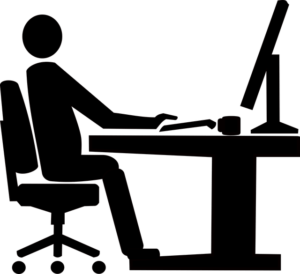SHP hears from Adam Clarke, Managing Director of Consulting at Praxis42 on display screen equipment (DSE), possible health issues from the increase in remote working and steps for organisations to avoid this.
Introduction

Adam Clarke, Managing Director of Consulting at Praxis42
DSE (Display Screen Equipment) has been a staple part of our working lives for many years now. So much so, that it’s easy to take it for granted. Whether we’re having a remote meeting, checking email, looking at a website or writing a white paper, it’s now incredibly easy to do all of those things wherever you happen to be.
In addition, we’re beginning to see that remote workers are often living much more sedentary lives, without the activity that being in, and getting to and from, a workplace carries with it.
Today I’ll look at the possible health implications agile working carries with it, and set out some steps every organisation can take to help employees stay healthy while they’re doing it.
Musculoskeletal disorders
As an overview, musculoskeletal disorders (MSDs) affecting the joints, bones and muscles are commonly caused by:
- Fixed or constrained body positions
- Continual repetition of movements
- Force that’s concentrated on small parts of the body (such as hands or wrists)
- Pace of work that doesn’t allow sufficient recovery between movements.
Official statistics from the HSE, with data up to March 2022 showed that in 2021/2022, there were 477,000 workers in Great Britain suffering from new or long-standing MSDs, leading to 7.3 million lost working days, almost a quarter of all work days lost due to ill health.
Revealingly, the HSE showed that prior to the pandemic, the rate of self-reported work-related MSDs was on a downward trend, but the latest figures show that trend has halted. Of the 477,000 MSD sufferers, 72,000 believed their condition was caused, or made worse, by the pandemic.
With more people using their home/remote set up more often, the potential for incorrect use, whether that’s due to posture, screen glare or bad positioning is now much greater.
Becoming less active
 MSDs are not the only health concern that remote working carries with it. While working remotely, and particularly if working from home, an employee can be less physically active. This became a trend during the lockdown, when a lot of common exercises were no longer available.
MSDs are not the only health concern that remote working carries with it. While working remotely, and particularly if working from home, an employee can be less physically active. This became a trend during the lockdown, when a lot of common exercises were no longer available.
The World Health Organisation (WHO) published guidelines in 2020 on physical activity and sedentary behaviour, in an attempt to positively impact upon and support the population’s physical and mental health.
The guidelines included simple targets for moderate/vigorous exercise and additional muscle-strengthening activities and highlighted the benefits. However, in-depth studies[1][2] of surveys conducted between 2001 and 2020 showed that more than a quarter (27.5%) of adults and over three quarters of adolescents (81%) were not meeting the requirements for aerobic exercises, and 80% of adults were falling short of the requirement for muscle strengthening[3]. The studies also demonstrated that over the last two decades, there were no significant improvements in the global levels of participation.
It seems that as a race, we’ve reached a less than optimal physical plateau.
Understanding the home-working environment
The first thing we can do to tackle these issues is learn about the remote-working set up that individuals have.
A 2020 Leesman survey of the home-working experience revealed that only 37% of respondents had a dedicated office or room, 33% had a dedicated work space (but not in a separate room), and 27% had a non-specific home location (i.e. a dining room table).
These results show us how difficult it can be to secure a correct workstation set up at home, where time and effort can be invested into basic actions like ensuring the desk/table and chair are the right height to encourage good posture.
DSE self assessments
 Although compliance with the DSE regulations is a legal requirement, it’s also important to recognise that these were written more than 30 years ago. Not only has the range of equipment we use changed, but the way we work has changed significantly too. The regulations are undoubtedly in need of an update, but until then, it’s worth taking extra steps to go above and beyond the legal requirements to help protect employees.
Although compliance with the DSE regulations is a legal requirement, it’s also important to recognise that these were written more than 30 years ago. Not only has the range of equipment we use changed, but the way we work has changed significantly too. The regulations are undoubtedly in need of an update, but until then, it’s worth taking extra steps to go above and beyond the legal requirements to help protect employees.
One way this can be done is to introduce extra health and wellbeing elements to a DSE assessment, and particularly a DSE self assessment carried out online by an employee working remotely.
BT Group, is a good example of an organisation doing this. It’s looking to promote health and wellbeing in the worker and the workplace. Employees can access the DSE self assessment online , where they not only provide information on both their office and home workspace, watch videos/animations on the correct way to set up equipment and order standard items to improve their set up, but they can access wellbeing tools (including stress management) and answer more health and wellbeing focused questions.
Innovating and tackling misinformation
There’s an appetite for digital diagnoses, with millions of people turning to Google for advice on all kinds of medical issues, including those common to MSDs. Unfortunately, there’s a lot of misinformation online too.
Forward-thinking organisations are looking to tackle this kind of misinformation by signposting genuine medical advice, treatment, exercises and habits within their own hubs. This not only promotes wider wellbeing within the organisation, but helps to circumnavigate the misleading and contradictory advice that can cause additional problems rather than help existing ones.
BT Group is also carrying out a study to integrate more health-focused resources into the safety risk management system, particularly when it comes to musculoskeletal (MSK) health where a collaborative approach and early intervention are seen as key to tackling the problem
This includes a trial of the integration of easily accessible mHealth system – using mobile devices to gather information to diagnose and treat MSK health conditions.
Good habits
 Also hard to implement remotely are the good habits that often come about naturally in the workplace. These include things like taking regular breaks from your screen, changing the activity you’re doing and even just switching off for a few minutes to have a non-work chat with a colleague.
Also hard to implement remotely are the good habits that often come about naturally in the workplace. These include things like taking regular breaks from your screen, changing the activity you’re doing and even just switching off for a few minutes to have a non-work chat with a colleague.
Because our screens are constantly with us, it can be easy to fall into the trap of always ‘being on’, whether that’s waking up and checking your emails in bed, or simply feeling the need to always be within arm’s length of your screen in case there’s a call or query. Although the commitment should be commended, this can lead to many hours without taking a break or even standing up.
Standing desks are one answer to this, but of course only if employees use them in the standing position. Perhaps all online meetings could be designated as ‘standing’ meetings, or if being on camera isn’t necessary, participants can move around while attending. Another option is to encourage 50-minute meetings rather than hour-long meetings, and suggest the spare 10 minutes are used to take a break.
Work-life balance
In fact, working from home can result in very blurred lines between work and home life, especially if there’s no separation of work space and life space. If the dining table you sit at to eat is also the desk you use to work for example, then work and life start to feel like the same thing.
This can stop you ever truly switching off at home, something that’s very important in order to recharge your own batteries. Anxiety, depression and stress can all start to become issues when workloads are building, you feel disconnected from colleagues and you feel like you’re always working.
It’s clear that with people working remotely, being constantly contactable and spending long hours with their screens, the potential for these mental health issues is even greater than it was before.
It can be very useful to re-introduce the natural separation between work and life we get when travelling to and from a workplace. This commute time can be useful. On the way to work, you have the time to mentally prepare for the day ahead. On the way home, you can decompress and relax into your evening. Compare this with getting up in the morning and immediately being at work. Or finishing for the evening and being expected to instantly be in home mode.
Having a walk before or after work can help recreate this separation between the two, as can things like gym sessions or swimming. Commuter activities like listening to a podcast or reading a book can also be used. The important thing is to try and re-establish the work-life balance, so you’re not primed to leap from one mode to the other.
Final thoughts
Let’s not underestimate the power of conversations. Many of the physical conditions covered here take years to develop into chronic conditions. By encouraging people to talk about aches and pains, and by taking those conversations seriously, we’ll be in a position to do something proactively about them.
When it comes to mental health, again conversations can be very powerful. Mental wellbeing is something that’s increasingly on the agenda, and although people may have been reluctant to talk about it in the past, it’s now a more accepted part of our working lives, with mental health first aid on the way to becoming as common as physical first aid. That’s something that will certainly benefit everybody, wherever we are.
Thanks go to Lina Chauhan (Group Ergonomic, Musculoskeletal & Wellbeing Specialist at BT) for contributing to this article.
References
[1] Guthold R, Stevens GA, Riley LM et al. Worldwide trends in insufficient physical activity from 2001 to 2016; a pooled analysis of 358 population-based surveys with 1.9 million participants. Lancet Global Health 2018, 6:e 1077-86
[2] Guthold R, Stevens GA, Riley LM et al. Global trends in insufficient physical activity among adolescents; a pooled analysis of 298 population-based surveys with 1.6 million participants. Lancet Child Adolescent Health 2020, 4: 23-25
[3] World Health Organisation, Global action plan on physical activity 2018 – 2030: more active people for a healthier world. Geneva, WHO, 2018.
Approaches to managing the risks associated Musculoskeletal disorders
In this episode of the Safety & Health Podcast, we hear from Matt Birtles, Principal Ergonomics Consultant at HSE’s Science and Research Centre, about the different approaches to managing the risks associated with Musculoskeletal disorders.
Matt, an ergonomics and human factors expert, shares his thoughts on why MSDs are important, the various prevalent rates across the UK, what you can do within your own organisation and the Risk Management process surrounding MSD’s.


 MSDs are not the only health concern that remote working carries with it. While working remotely, and particularly if working from home, an employee can be less physically active. This became a trend during the lockdown, when a lot of common exercises were no longer available.
MSDs are not the only health concern that remote working carries with it. While working remotely, and particularly if working from home, an employee can be less physically active. This became a trend during the lockdown, when a lot of common exercises were no longer available. Although compliance with the
Although compliance with the  Also hard to implement remotely are the good habits that often come about naturally in the workplace. These include things like taking regular breaks from your screen, changing the activity you’re doing and even just switching off for a few minutes to have a non-work chat with a colleague.
Also hard to implement remotely are the good habits that often come about naturally in the workplace. These include things like taking regular breaks from your screen, changing the activity you’re doing and even just switching off for a few minutes to have a non-work chat with a colleague.
No mention of Product Safety or over-exposure to “out of the box” sub-optimal maximum brightness, super high-contrast and making personal custom “Reasonable Adjustments or Accommodation”, colour contrast calibrated settings to prevent or mitigate the chain of causation of “Computer Vision Syndrome” a serious causal factor in, DSE operators occupational health, presenteeism suffering debilitating visual repetitive stress injuries myopic and asthenopic disease.
https://icd.who.int/browse10/2016/en#/H53.1